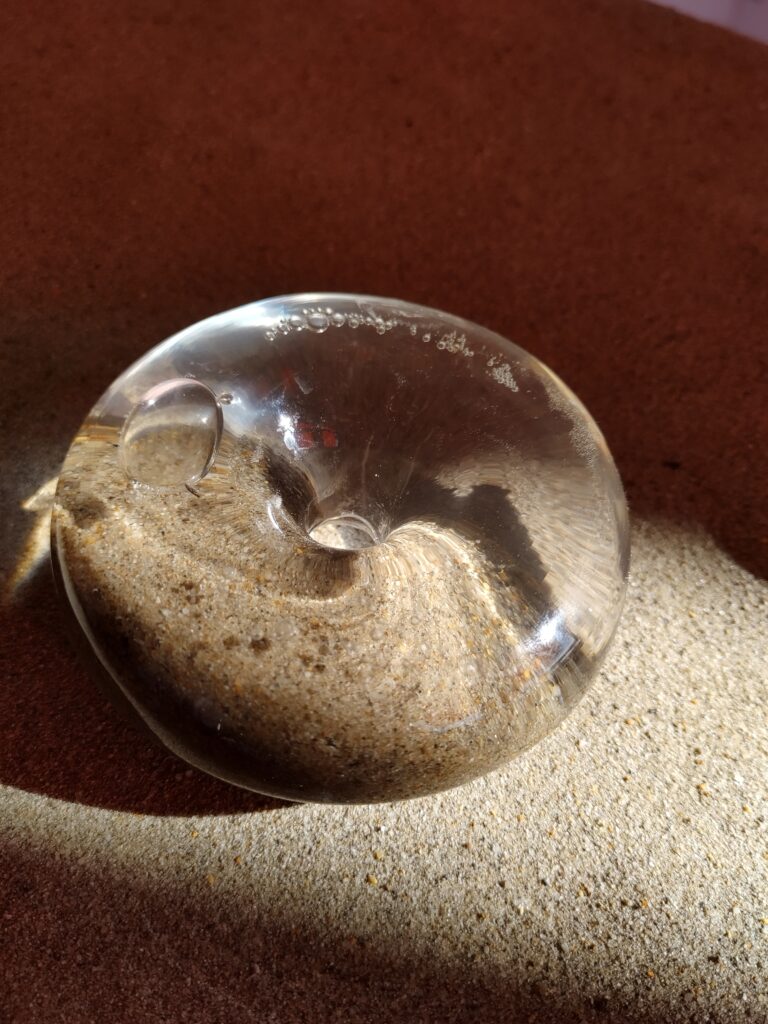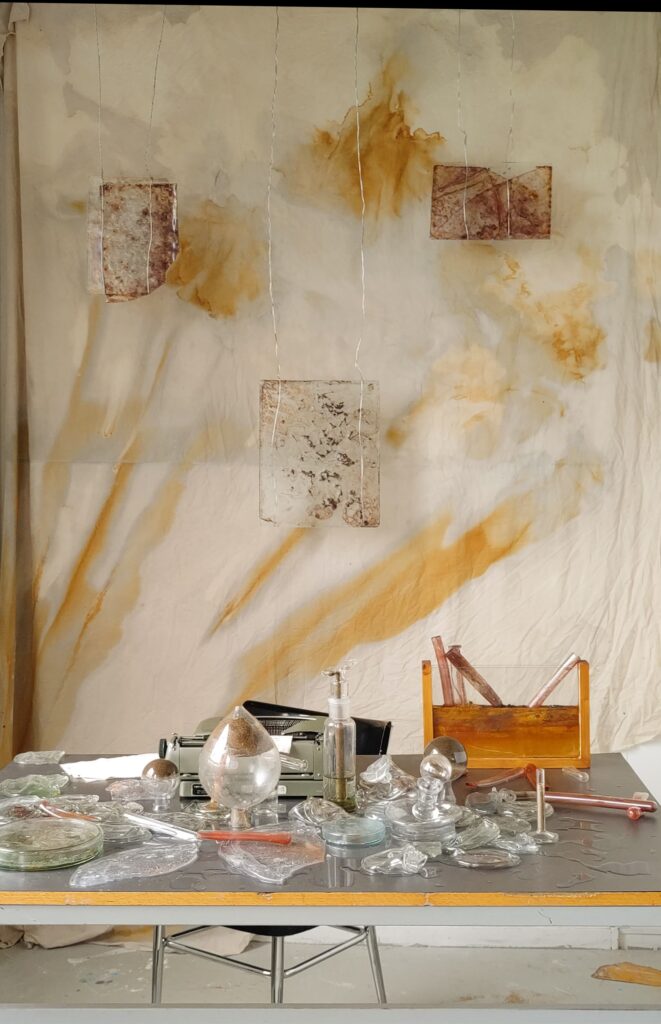
Ster Borgman
2023
- Artist Statement -
2022
I Als kunstenaar onderzoek ik natuurlijke processen, hun verhalen en betovering. Als een alchemist transformeer, extraheer of versmelt ik deze chemie. Ik extraheer pigment uit planten, smelt zand om tot glas en transformeer roest tot druipende rode vormen in glas. Ik ben geïnteresseerd in waar wetenschap grenst aan magie, het vlak waar we te weinig weten om het te begrijpen maar het wel kunnen opmerken. In mijn werk komt soms een sensuele aard naar voren, waarbij ik natuurlijke pigmenten en hun biochemische relatie met het menselijk lichaam onderzoek. Ik maak pigmenten van materialen die ik tijdens wandelingen verzamel en experimenteer met oxides van oude metalen, vermalen gesteentes en plantaardige kleurstoffen. Ook ben ik geïnteresseerd in de queerness van de natuur, die ik zie als iets grenzenloos en vloeibaars. Denk aan het druipen van glas, het lekken van roest en de smakelijke, haast sensuele kleuren van bloemen en planten. Met mijn alchemie vertroebel ik het koloniale raster van de wetenschap wat de wereld verdeelt in verschillende groepen zoals gender, quantum deeltjes en levende of niet-levende natuur. Zo breng ik mijn publiek in verwondering voor de niet menselijke natuur.

Rust crystals on metal - 5cm
- Greenhouse -
2023
I see myself as a magical scientist. I have been working with rust in glass as a natural pigment for my graduation in Fine Art at ArtEZ. I built a greenhouse out of pigmented glass that makes the overgrowing quality of rust visible. I grew up in Aalsmeer, an area with old greenhouses. Some of them are abandoned and overgrown, making you wonder what grows inside. Rust is a growing crystal that slowly overgrows.

380 x 230 x 275
Rust acts like it is not moving, but when you look away it starts dripping and leaking everywhere. I have been researching rust and glass as a queer way to leak out of the structure of Western science.
By making a greenhouse I attempt to make the overgrowing quality of rust visible. For building the greenhouse I used the authentic wooden structure.
I used old greenhouse wood and all the glass I used is from old greenhouses. The unstained glass in between is not melted in my glass oven. It is unaltered old greenhouse glass with some traces of plants or moss, the previous conqerers of the greenhouse.

each plate is 45x40

Rust moves in a very slow time frame: it bursts out of the earth in the form of iron, oxidizes with rain, crystalizes and eventually it might again drip into the heat of the earth to melt back into iron. I make black rust pigment and melt it in between pairs of glass plates in an oven at around 800˚C. The glass melts together and fixates the rust, which starts to boil and drip. Eventually, the rust changes colour by the heat – from black to different shades of red. These glass plates are stills, showing a fraction in the long life of rust in deep time. But perhaps after a year, eight years or eight hundred years, the glass breaks, crumbles back to sand and the rust will be free again.

- Stills of Deeptime -
2023
For my graduation at Fine Art in Arnhem 2023 I worked with rust and glass. Rust is something hybrid, something that grows and can overgrow. When I look at glass it pretends not to move, but when I look away it starts to drip and flow everywhere: it is slow, but unstoppable. In my artpractice I have worked a lot with rust. It all started with my fascination for colors and pigments. For six years I have been making my own pigments from plants, which I pick in my own garden or in the wild.

Plate 3/3 - 90x140 (glass, rust, steel - glassfusion)
I often dye organic fabrics with the pigments or use it as paint on paper. I also like to work with ceramics and glass, but unfortunately I was never able to process the pigments that I get from plants in my ceramics or glass, because those kilns reach temperatures between 800˚C and 1240˚C which make all the vegetable pigments totally roasted and black. Rust is an anorganic material that cannot get roasted in a glass oven, instead it actually transforms. So it turned out to be applicable to ceramics and glass.
I look for rusty items along the riverside and put them in a jar filled with water to make them rust even more. The longer I leave the rusty finds in water, the more black the rust becomes. This is what I use as pigment. The pigment I have now has been in water for five years. I fixed this pigment between two glass plates in an oven at around 800˚C. There, the glass finally fuses together and fixates the rust, which boils, and tries to escape. Eventually, the rust changes color from black to various shades of red, due to the heat. These glass plates are stills of a moment in deep time. But maybe the glass breaks after a year, 9 years or even 9 million years, crumbles into sand and the rust is free again.
Rust tells a story of deep time; how it erupts from the earth in the form of iron, then oxidizes through the rain and finally seeps back into the earth to melt back into iron. The longer I leave the rusty finds in water, the blacker the rust pigment becomes. The pigment I have now has been in water for five years. I fixed this pigment between two glass plates in an oven at around 800˚C.

Plate 3/3 - 90x140 (glass, rust, steel - glassfusion)

Plate 1/3 - 90x140 (glass, rust, steel - glassfusion)
- River Seeds -
2022

The Story:
I found these river seeds along the riverside. They form in wild whirl pools over time and seem to be very rare. The center of the whirl gets so much pressure of the whirling water around it that it slowly solidifies. Not by temperature but by pressure. This is how a river seed gets formed. If it is planted, a little puddle appears that starts slowly growing bigger and bigger. A water source will grow out of it, and when it is given enough time to grow, a new river will form itself.

Sand Containers 10cm - glassblowing
The transformation of water into ice is similar to the transformation of sand into glass. With the enchanted approach I have towards science , I try to figure out if I can melt sand to ice and freeze water to glass. I filled the glass with water and sand from the river Rhine in Arnhem. I carefully drilled a hole in the glass and closed it after I filled it up.
Click on image for video of A River Seed - 14cm
The doughnut shaped glass objects are handblown, but not by myself. I did however glassblow the objects on the left myself. These contain different types of sands from different places along the river Chervo in Italy. I made these glass objects during an artist-in-residence program at Fondazione Pistoletto.
- Natural Dyes -
2018
For years now I have been dying recycled or organic fabric with different plants from my own garden and its surrounding area. During the dying process of these colors, I wanted to have more and more. I became greedy, and it felt as if I could
taste the colors. As if I wanted to eat the colors. As humans we can see quite a lot of colors. This makes us see if fruit and other plants are ripe. It can also warn us for toxic plants or stingy insects. Some colors are linked to fruit, to sugar and energy, while others might be linked to poisonous mushrooms. At this moment I have a collection of over 150 colors. I brew vats of plants like nettle or goldenrod flowers. I let it simmer for one hour in a pot.

Selections of my color archive.

I need to prepare the fabric with alum and green soap to open the fibres up for the color. After another hour of simmering, this time together with the fabric, the color is dyed into the fabric. After it is washed and dryed again, I can change the existing color on the fabric by dipping it in rust, soda or vinegar. Sometimes a bright yellow color, for instance from goldenrod, can drastically turn into a deep green by only dipping it into a bath of rust and water.
- Pentagon Hive -
2022
In this project I made a beehive with a pentagonial structure, though beehives always have hexagonial structures. I made a silicone mold of a 3D printed pentagon shaped pattern. I melted organic-dynamic beeswax into that mold. It looks, smells, and feels exactly like a beehive, but instead of the real hexagrams you now see pentagons; something impossible in real life.
I am interested where science and fantasy come together. I turned a natural proces into a fairytale to let the viewer believe something surreal is true. I have been creating stories and surreal objects to define the magical theories I have. If I try to convince my audience that my scientific fairytales are true, I make them wonder what is true. Doubting what they thought they knew about the world around them. I want them to feel like that, because I try to create a curiosity about the structure of science. Through storytelling I try to make them think of new approaches to science.

Hive with pentagonial shaped combs 70x40 (biodynamic beeswax)

Pentagonial beehive in the wild.
The Story:
Hive building insects have been making hexagons for over 50 million years. This method uses less wax than structures of squares or triangles that they build 100 million years ago. So why did these wild bees decide to build pentagrams?
Since most flowers that represent the number six in their centers are becoming extinct more and more, bees get influenced by the still existing and steadily thriving flowers like those of most fruits which represent the number five in their centers. They adjust their hives to their environment.
- Magical Scientist Persona -
2022

I created this magical scientist persona, who researches surreal things, like the surreal objects I make. This persona is a very nice way for me as an artist to communicate with my audience. I can make them believe something surreal is true and therefore make them doubt what they actually know.
Video of my persona
Previously to Fine Art I studied Moving Theatre for one year at the Mime academy in Amsterdam. I eventually chose for Fine Art, since I did not feel free enough to make my surreal objects, which are a big part of the whole story. Next to the studies at ArtEZ I have been professionally performing in a theatre production and asked for several performances.